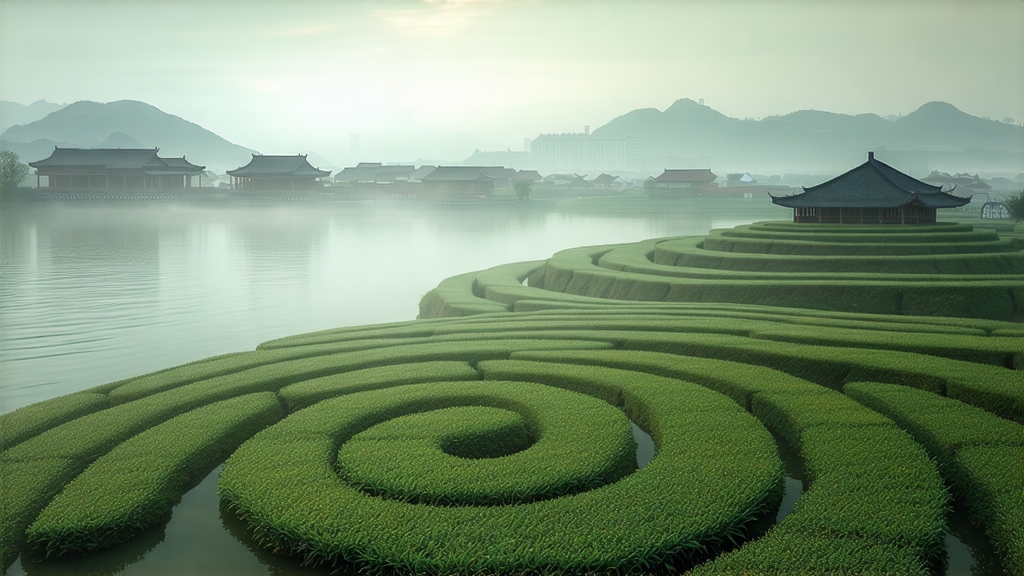
Biluochun, whose name translates literally to “Green Snail Spring,” is one of China’s ten most celebrated teas, yet it remains curiously under-appreciated outside specialist circles. Grown on the mist-locked islands of Dongting Shan in Lake Tai, Jiangsu Province, this delicate green tea has been seducing emperors, poets and merchants since the late Ming dynasty. Its tiny, spiral-shaped leaves, downy silver tips and intoxicating bouquet of apricot, orchid and fresh pea tendrils make it instantly recognizable once encountered, but its story is as intricate as the curls themselves.
Historical whispers place the tea’s birth around 1675, when a tea picker, startled by the sudden strength of the spring aroma, cried out “Xia Sha Ren Xiang” – “scary fragrance.” The name stuck until the Kangxi Emperor, touring the region in 1699, found the moniker inelegant and rechristened it Biluochun, referencing both its jade color and the snail-shell curve of the finished leaf. From that moment the tea entered the imperial tribute list, dispatched northward in small, sealed bamboo cylinders carried by fast boats along the Grand Canal. European traders first recorded it in 1740 as “Pi-lo-chun,” noting that one liang (roughly 50 g) exchanged for the same weight of silver in Canton’s Thirteen Factories.
Geography is destiny for Biluochun. The Dongting archipelago rises from a shallow, mineral-rich lake whose microclimate traps humid morning mists that act like a natural shade cloth, slowing photosynthesis and concentrating amino acids—especially L-theanine—inside the tender leaf. Soils are acidic, a mix of granite detritus and lake-bed silt laced with iron and magnesium. Thirty percent of the mountain is planted with fruit trees—peach, plum, apricot and loquat—whose roots intermingle with tea bushes, adding floral volatiles that the leaves absorb like living blotting paper. No other Chinese green tea enjoys such an intensely aromatic terroir.
Although all Biluochun comes from Jiangsu, three distinct grades exist. “Supreme Original” (Dongting Original) is picked before Qingming festival from a 900-hectare core zone on Dongting Dongshan and Xishan islands; only buds or one bud-and-half-open-leaf sets are taken. “Lake Tai” grade expands the radius to the lake’s northern shore, where bushes are younger and the mist less consistent. “Extended Jiangsu” grade is grown as far north as Yixing and as south as Wuxi, harvested later and often machine-trimmed. Purists insist that true Biluochun must be hand-plucked within sight of the lake’s water, arguing that the island’s terroir is irreproducible.
The crafting choreography has changed little in three centuries. Picking begins at 5 a.m., when dew still weighs down the leaf, keeping it supple for the kill-green stage. Leaves are spread in bamboo trays no thicker than two centimeters and withered for three hours under soft mountain breeze; this reduces grassy notes and initiates enzymatic quieting. Next comes the unique “killing-green while rolling” step: a 140 °C wok, brushed only with lake water, receives 250 g of leaf. The master’s bare hands flutter through the mass for precisely 4.5 minutes, simultaneously pan-firing and spiral-twisting each bud against the iron surface. The motion is wrist-driven, like turning tiny glass beads, and requires eight years of apprenticeship to avoid scorching the down. After the leaf temperature drops to 38 °C, a second rolling—this time on bamboo mats—tightens the curl and sets the silver fuzz. Finally, a gentle charcoal bake (60 °C for 40 minutes) drives residual moisture to 4 %, locking in the orchid note that defines the tea.
Water choice is non-negotiable. Locals swear by morning lake water drawn 300 m from shore, filtered through reed beds; elsewhere, low-TDS spring water at 8–12 °C hardness is acceptable. Heat to 75 °C, never above 80 °C, to preserve the bud’s glutinous sweetness. A tall, thin-walled glass (180 ml) allows the spirals to dance downward in what connoisseurs call “the snow falling through spring sky.” Use 3 g of leaf—roughly forty buds—for the first infusion. After a 15-second rinse to awaken the leaf, steep 25